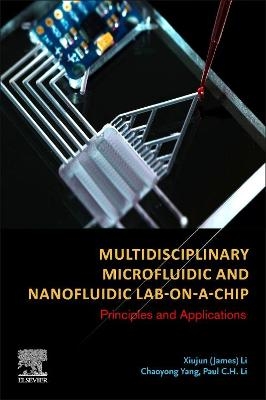
Multidisciplinary Microfluidic and Nanofluidic Lab-on-a-Chip
Elsevier Science Ltd (Verlag)
978-0-444-59432-7 (ISBN)
Calculations, solved problems, data tables, and design rules are provided to help researchers understand microfluidic basic theory and principles and apply this knowledge to their own unique designs. Recent advances in microfluidics and microsystems for life sciences are impacting chemistry, biophysics, molecular, cell biology, and medicine for applications that include DNA analysis, drug discovery, disease research, and biofluid and environmental monitoring.
XiuJun (James) Li, Ph.D., is an Associate Professor with early tenure in the Department of Chemistry and Biochemistry, Biomedical Engineering, and Border Biomedical Research Center at the University of Texas at El Paso (UTEP), USA. After he obtained his Ph.D. degree in microfluidic lab-on-a-chip bioanalysis from Simon Fraser University (SFU) in Canada in 2008, he pursued his postdoctoral research with Prof. Richard Mathies at University of California Berkeley and Prof. George Whitesides at Harvard University, while holding a Postdoctoral Fellowship from Natural Sciences and Engineering Research Council (NSERC) of Canada. He has gained extensive experience in bioanalysis using microfluidic systems, such as single-cell analysis, genetic analysis, low-cost diagnosis, pathogen detection, 3D cell culture, and so on. Dr. Li’s current research interest is centered on the development of innovative microfluidic lab-on-a-chip and nanotechnology for bioanalysis, biomaterial, biomedical engineering, and environmental applications, including but not limited to low-cost diagnosis, nano-biosensing, tissue engineering, and single-cell analysis. He has coauthored about 100 publications in high-impact journals (such as Adv. Drug Deliv. Rev, Appl. Catal. B-Environ, Anal. Chem., Lab Chip, Biosens. Bioelectron.) and 22 patents, including two books from Elsevier on microfluidic devices for biomedical applications. He is an Advisory Board member of Lab on a Chip and Analyst, the Founder of microBioChip Diagnostics LLC, and an editor of 6 journals including Scientific Reports from the Nature publishing group, Micromachines, etc. He is the recipient of the “Bioanalysis New Investigator Award in 2014, UT STARS Award in 2012, NSERC Postdoctoral Fellow Award in 2009, and so on. For more information, please visit http://li.utep.edu. Dr. Chaoyong Yang received his PhD from University of Florida in 2006 under the guidance of Professor Weihong Tan. He joined Professor Richard Mathies’ group at the University of California, Berkeley as a postdoc. In 2008, he joined Xiamen University where he is now a Distinguished Professor in the Department of Chemical Biology. Professor Yang has published over 200 articles in international journals which have received over 11 000 citations, and is named inventor on over 40 patents. He serves as associate editor for ACS Applied Bio Materials. He is a Fellow of the Royal Society of Chemistry. He is the recipient of CAPA Distinguished Faculty Award in 2012, National Outstanding Young Investigator Award in 2013, Chinese Young Analyst Award in 2015, Chinese Chemical Society-Royal Society of Chemistry Young Chemist Award in 2016, and 2021 ACS Advances in Measurement Science Lectureship Award. His current research is particularly focused on bio-sensing, high throughput evolution, single cell analysis and microfluidics. Dr. Paul Li obtained his Ph.D. in analytical chemistry at the University of Toronto, and conducted postdoctoral work at the University of Alberta. Then, he developed the microfluidic lab-on-a-chip at Simon Fraser University, where he was promoted to full professor. Dr. Li is interested in integrating chip microfluidics for chemical sensing, single-cell analysis, and nucleic acid bioassay. He has been visiting professors at Johannes Gutenberg Universitat-Mainz (Germany), Griffith University (Australia) and City University of Hong Kong. Dr. Li has published several books, e.g. Fundamentals of lab on a chip for biological analysis and discovery, and Microarray Technology: Methods and Applications. He is associate editor of Canadian Journal of Pure and Applied Sciences, and sits on the editorial board of Hong Kong Pharmaceutical Journal. Dr. Li is the inventor of six patented technologies and 5 pending patents, and he is the founder of ZellChip Technologies Inc. specializing in microfluidics-based instruments and solutions.
Part I: Fundamentals of microfluidic/nanofluidic lab-on-a-chip1. Micromachining Methods2. Micromachining of silicon, glass devices3. Micromachining of polymers4. Fabrication of paper-based microfluidic devices5. Biocompatibility and surface modifications6. Systems interconnect and world-to-chip interface7. Microfluidic Flow control
Part II: New Emerging Techniques8. Droplet microfluidics9. Closed-channel Droplet generation10. Open-format Digital microfluidics11. Nanofluidics12. Nanofabrication13. Characteristics of nanofluidics
Part III: Applications14. Applications to Cell Biology15. Manipulation of cells 16. Cellular measurements and analysis17. Single-cell analysis18. 3D cell culture19. Organs-on-a-chip20. Applications to Nuclei Aids Analysis21. Nucleic acids extraction and purification22. Nucleic acids amplification23. Forensic DNA typing24. Microarray DNA chips25. Applications to proteins analysis26. Immunoassay27. Protein separation28. Enzymatic analysis29. Proteomics30. Applications to global health31. Low-cost Paper-based diagnosis devices32. Field diagnosis33. Other applications43. Environmental analysis44. Forensic analysis45. Small ions and molecules analysis46. Microreacter47. Perspective48. Instrument/device commercialization
| Erscheinungsdatum | 01.07.2017 |
|---|---|
| Verlagsort | Oxford |
| Sprache | englisch |
| Maße | 191 x 235 mm |
| Gewicht | 1000 g |
| Themenwelt | Naturwissenschaften ► Chemie ► Technische Chemie |
| Naturwissenschaften ► Physik / Astronomie ► Strömungsmechanik | |
| Technik | |
| ISBN-10 | 0-444-59432-9 / 0444594329 |
| ISBN-13 | 978-0-444-59432-7 / 9780444594327 |
| Zustand | Neuware |
| Informationen gemäß Produktsicherheitsverordnung (GPSR) | |
| Haben Sie eine Frage zum Produkt? |
aus dem Bereich


